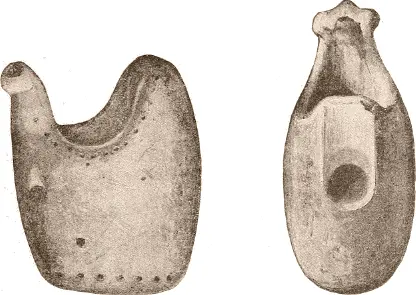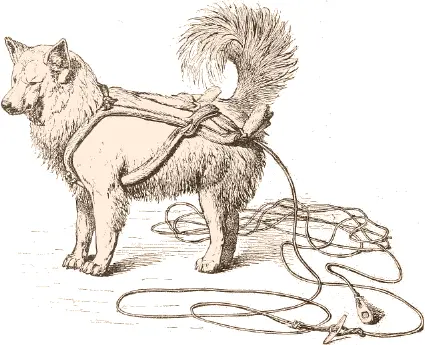
Fig. 483. Sledge shoe. (National Museum, Washington. 34096.) ¼
The shoe (Fig. 483) is either tied or riveted to the runner. If tied, the lashing passes through sunken drill holes to avoid any friction in moving over the snow. The right and left sides of a whale’s jaw are frequently used for shoes, as they are of the proper size and permit the shoe to be of a single piece. Ivory is cut into flat pieces and riveted to the runner with long treenails. The points are frequently covered with bone on both the lower and upper sides, as they are easily injured by striking hard against hummocks or snowdrifts. Sometimes whalebone is used for the shoes.
The cross bars (napun) project over the runners on each side and have notches which form a kind of neck. These necks serve to fasten the thongs when a load is lashed on the sledge. The bars are fastened to the runners by thongs which pass through two pairs of holes in the bars and through corresponding ones in the runners. If these fastenings should become loose, they are tightened by winding a small thong round them and thus drawing the opposite parts of the thong tightly together. If this proves insufficient, a small wedge is driven between the thong and the runner.

Fig. 484. Clasp for fastening traces to sledge. (National Museum, Washington. 34110.) ½
The antlers attached to the back of the sledge have the branches removed and the points slanted so as to fit to the runners. Only the brow antlers are left, the right one being cut down to about three inches in length, the left one to one and a half inches. This back forms a very convenient handle for steering the sledge past hummocks or rocks, for drawing it back when the points have struck a snowdrift, &c. Besides, the lashing for holding the load is tied to the right brow antler and the snow knife and the harpoon line are hung upon it.

Fig. 485. Artistic form of clasp for fastening traces to sledge. (Museum für Völkerkunde, Berlin.) 1/1
Under the foremost cross bar a hole is drilled through each runner. A very stout thong (pitu) consisting of two separate parts passes through the holes and serves to fasten the dogs’ traces to the sledge. A button at each end of this thong prevents it from slipping through the hole of the runner. The thong consists of two parts, the one ending in a loop, the other in a peculiar kind of clasp (partirang). Fig. 484 represents the form commonly used. The end of one part of the thong is fastened to the hole of the clasp, which, when closed, is stuck through the loop of the opposite end (see Fig. 482). A more artistic design is shown in Fig. 485. One end of the line is tied to the hole in the under side of this implement. When it is in use the loop of the other end is stuck through another hole in the center and hung over the nozzle. The whole represents the head of an animal with a gaping mouth. The dogs’ traces are strung upon this line by means of the uqsirn, an ivory implement with a large and a small eyelet (Fig. 486). The trace is tied to the former, while the latter is strung upon the pitu.

Fig. 486. Uqsirn, for fastening traces to pitu.
a (National Museum, Washington. 34122.) 1/1 b (Museum für Völkerkunde, Berlin.) ½
The dogs have harnesses (ano) made of sealskin (Fig. 487) or sometimes of deerskin, consisting of two bights passing under the fore legs. They are joined by two straps, one passing over the breast, the other over the neck. The ends are tied together on the back, whence the trace runs to the sledge. According to Parry (II, p. 517), the Iglulik harnesses consisted of three bights, one passing over the breast and shoulder and two under the fore legs.

Fig. 487. Ano or dog harness. (Museum für Völkerkunde, Berlin. IV A 6730.)
It was mentioned at another place ( p. 475) that in sealing a dog is taken out of the sledge to lead the hunter to the breathing hole. For this purpose the traces of some harnesses are made of two pieces, which are united by the sadniriaq, a clasp similar to that of the pitu (Figs. 487, 488). If the dog is to be taken from the sledge the fore part of the trace is unbuttoned.

Fig. 488. Sadniriaq or clasp. (National Museum, Washington.) ⅔
Besides this form of sledge a great number of others are in use. Whenever whales are caught their bone is sawed or cut into large pieces, which are shod with the same material. If large bones are not to be had, a substitute is found in walrus skins or rolls of sealskins, which are wetted and sewed up in a bag. This bag is given the desired form and after being frozen to a solid mass is as serviceable as the best plank. In Boothia frozen salmon are used in the same way and after having served this purpose in winter are eaten in the spring. Other sledges are made of slabs of fresh water ice, which are cut and allowed to freeze together, or of a large ice block hollowed out in the center. All these are clumsy and heavy and much inferior to the large sledge just described.
Parry (II, p. 515) states that at Igiulik the antlers are detached from the sledge in winter when the natives go sealing. The tribes of Davis Strait do not practice this custom, but use scarcely any sledge without a pair of antlers.
As to the appearance of the dogs I would refer to Parry (II, p. 515) and other writers and confine my remarks to a description of their use by the Eskimo.
As the traces are strung upon a thong, as just described, the dogs all pull at one point; for that reason they may seem, at first sight, to be harnessed together without order or regularity; but they are arranged with great care. The strongest and most spirited dog has the longest trace and is allowed to run a few feet in advance of the rest as a leader; its sex is indifferent, the choice being made chiefly with regard to strength. Next to the leader follow two or three strong dogs with traces of equal length, and the weaker and less manageable the dogs the nearer they run to the sledge. A team is almost unmanageable if the dogs are not accustomed to one another. They must know their leader, who brings them to terms whenever there is a quarrel. In a good team the leader must be the acknowledged chief, else the rest will fall into disorder and refuse to follow him. His authority is almost unlimited. When the dogs are fed, he takes the choice morsels; when two of them quarrel, he bites both and thus brings them to terms.
Generally there is a second dog which is inferior only to the leader, but is feared by all the others. Though the authority of the leader is not disputed by his own team, dogs of another team will not submit to him. But when two teams are accustomed to travel in company the dogs in each will have some regard for the leader of the other, though continuous rivalry and quarrels go on between the two leaders. Almost any dog which is harnessed into a strange team will at first be unwilling to draw, and it is only when he is thoroughly accustomed to all his neighbors and has found out his friends and his enemies that he will do his work satisfactorily. Some dogs when put into a strange team will throw themselves down and struggle and howl. They will endure the severest lashing and allow themselves to be dragged along over rough ice without being induced to rise and run along with the others. Particularly if their own team is in sight will they turn back and try to get to it. Others, again, are quite willing to work with strange dogs.
Читать дальше


















